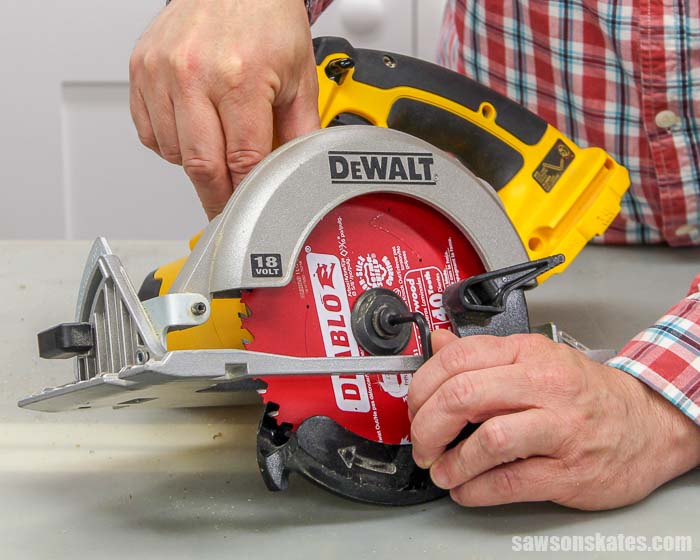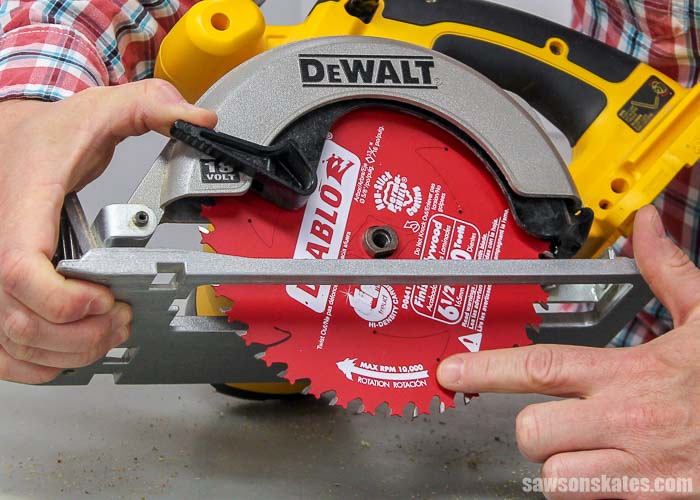Is the curious side of you wondering, “Which way does a circular saw blade face?” Well, you’ve come to the right place! Let’s dive into the fascinating world of circular saws and uncover the answer to this intriguing question.
Now, imagine you’re holding a circular saw in your hands, ready to tackle your next woodworking project. But before you rev up that powerful tool, it’s crucial to know the proper orientation of the saw blade. So, let’s get down to the nitty-gritty and find out which way the blade should face.
Whether you’re a seasoned DIY enthusiast or just starting your woodworking journey, understanding the direction in which a circular saw blade should face is essential for your safety and the efficiency of your cuts. So, let’s unravel this mystery!

The Correct Way to Position a Circular Saw Blade
When using a circular saw, one of the most important factors to consider is the correct positioning of the saw blade. Many people may not realize that the way a circular saw blade faces can impact the quality of the cut, the safety of the user, and the overall performance of the tool. In this article, we will explore the proper orientation of a circular saw blade and the reasons behind it. By understanding this vital aspect, you can improve your cutting experience and achieve better results in your woodworking projects.
Why Does the Direction of the Circular Saw Blade Matter?
The direction in which a circular saw blade faces is crucial for several reasons. First and foremost, safety is a primary concern. When the blade is mounted correctly, with the teeth facing downwards, the rotation of the blade feeds the material towards the base of the saw. This allows the saw to efficiently cut through the material while minimizing the risk of kickback. Kickback occurs when the blade catches on the material and kicks back towards the user, which can result in severe injuries.
In addition to safety, the direction of the blade also affects the quality of the cut. With the teeth facing downwards, the blade cuts through the material in a smooth and controlled manner. The saw’s motor and design are optimized for this orientation, allowing for accurate and clean cuts. If the blade is installed incorrectly, with the teeth facing upwards, it can lead to rough cuts, tear-out, and an overall poor finish.
Lastly, the performance of the circular saw can be compromised if the blade is facing the wrong way. When the saw is operated with the blade in the correct orientation, the motor and other components are working in synergy to deliver the desired cutting power and efficiency. Turning the blade around can cause strain on the motor, reduced cutting speed, and excessive wear on the blade itself. Therefore, it is essential to ensure the blade is facing the right direction for optimal performance.
The Correct Way to Install a Circular Saw Blade
Installing a circular saw blade may seem straightforward, but it is crucial to do it correctly to ensure safety and performance. Here are the steps to follow:
- Unplug the circular saw from the power source to prevent any accidental starts.
- Set the saw on a stable surface with the blade facing upwards.
- Loosen the arbor nut using the wrench provided or an appropriately sized wrench.
- Remove the old blade by sliding it off the arbor.
- Carefully inspect the new blade for any damage or defects before installation.
- Align the blade with the arbor, ensuring that the teeth are facing downwards.
- Tighten the arbor nut securely, but be careful not to overtighten.
- Give the blade a gentle spin to check for any wobbling or misalignment. If necessary, adjust and retighten the arbor nut.
By following these steps, you can properly install a circular saw blade with the teeth facing in the correct direction. Remember to always double-check the blade orientation before starting any cutting tasks to ensure your safety and achieve the best results.
Benefits of Properly Positioning a Circular Saw Blade
Properly positioning a circular saw blade offers numerous benefits that extend beyond safety and performance:
- Accurate and clean cuts: With the blade facing the right way, you can achieve precise cuts with minimal tear-out.
- Improved efficiency: The saw’s motor is designed to work optimally with the blade oriented in the proper direction, resulting in increased cutting speed and improved efficiency.
- Extended blade life: When the blade is facing the correct way, it experiences less strain and wear, leading to a longer lifespan.
- Reduced maintenance and repair costs: By using the saw as intended, you can avoid unnecessary damage to the motor and other components, saving you money on repairs.
- Enhanced safety: Installing the blade correctly significantly reduces the risk of kickback, preventing potential injuries.
Tips for Using a Circular Saw Safely
While properly positioning the circular saw blade is crucial for safety, there are other tips you should keep in mind when using this powerful tool:
- Always wear safety goggles, hearing protection, and appropriate work gloves.
- Ensure the material you are cutting is properly secured to prevent movement during cutting.
- Adjust the depth of the blade to match the thickness of the material to be cut, ensuring that the blade protrudes just enough for efficient cutting.
- Use a guide or straight edge to help you achieve straight cuts.
- Avoid cutting materials with knots or other defects that may cause the blade to bind.
- Never force the saw through the material. Let the blade do the work with moderate pressure.
- Make sure you have a firm grip on the saw’s handle and maintain control throughout the entire cutting process.
- Allow the blade to come to a complete stop before setting the saw down.
Common Questions About Circular Saw Blade Orientation
1. Is it dangerous to install a circular saw blade the wrong way?
Installing a circular saw blade the wrong way can be dangerous. It increases the risk of kickback, which can lead to serious injuries. Additionally, the quality of the cut may be compromised, and the performance of the saw may be negatively affected. Always ensure the blade is facing the correct direction to minimize these risks.
2. Can you reverse a circular saw blade for different cuts?
No, you should not reverse a circular saw blade for different cuts. Circular saw blades are designed to operate with the teeth facing downwards for safety, performance, and optimal results. Reversing the blade can lead to poor cut quality, increased risk of kickback, and strain on the saw’s motor.
3. How often should I replace my circular saw blade?
The frequency of replacing a circular saw blade depends on several factors such as the type of material being cut, the frequency of use, and the quality of the blade. As a general guideline, a blade should be replaced when it becomes dull, loses its cutting efficiency, or if the teeth are damaged. Regular inspection and maintenance will help you determine when it’s time for a replacement.
Key Takeaways: Which Way Does a Circular Saw Blade Face?
- A circular saw blade should face downwards with the teeth pointing towards the front of the saw.
- The rotation of the blade should also be considered, as it needs to match the direction specified by the manufacturer.
- Ensuring the blade is properly aligned and facing the right way is crucial for safety and efficient cutting.
- Always refer to the user manual or instructions provided by the manufacturer for specific blade orientation.
- Regularly inspect the blade for any signs of damage or wear, and replace it if necessary.
Frequently Asked Questions
When it comes to using a circular saw, understanding the correct direction for the blade is crucial. Below are five commonly asked questions about which way a circular saw blade should face.
1. How should the teeth of a circular saw blade be oriented?
The teeth of a circular saw blade should always be facing downwards, towards the surface you are cutting. This ensures that the blade cuts through the material smoothly and minimizes splintering. The sharp teeth on the bottom of the blade are designed to push down into the material, providing a clean and controlled cut.
If the teeth are facing upwards, the blade will be cutting in the wrong direction and can cause the saw to kick back, which can be dangerous. It is important to check the orientation of the blade before starting any cutting task.
2. Can a circular saw blade be installed upside down?
No, a circular saw blade should never be installed upside down. This means that the teeth should always be facing down and the saw’s rotation should be such that the bottom of the blade is cutting into the material. Installing the blade upside down would result in the top of the blade doing the cutting, which is not the intended design.
Installing the blade upside down can lead to poor cutting performance, increased risk of kickback, and potential damage to the saw or the material being cut. Always ensure that the blade is correctly oriented before operating the circular saw.
3. Are there any exceptions to the downward-facing teeth rule?
Generally, the teeth of a circular saw blade should face downwards. However, there are specialized blades called “up-cut” blades that are designed for certain applications. These blades have reversed tooth orientation, with the teeth facing upwards. They are commonly used for cutting materials like plastic or aluminum, where a clean top surface is desired.
It is important to read the manufacturer’s instructions and recommendations for each specific blade to ensure it is being used correctly. Unless you are using a specialized blade that explicitly states otherwise, remember to follow the downward-facing teeth rule.
4. How should the blade direction be adjusted on a circular saw?
Adjusting the blade direction on a circular saw is typically done by changing the way the blade is mounted on the saw’s arbor. The arbor is the shaft that the blade attaches to. By loosening the arbor nut, the blade can be positioned so that its teeth face in the desired direction.
Refer to the circular saw’s user manual for specific instructions on how to adjust the blade direction. It is important to properly tighten the arbor nut after making any adjustments to ensure the blade is securely in place before use.
5. Can a circular saw blade be used for both ripping and crosscutting?
Yes, a circular saw blade can be used for both ripping and crosscutting, but it is recommended to use different blades for each type of cut. Ripping blades have fewer teeth and are designed for cutting along the grain of the material, making them ideal for making long cuts. Crosscutting blades have more teeth and are better suited for cutting across the grain, resulting in smoother and cleaner cuts.
Using the appropriate blade for each type of cut ensures better cutting performance, reduces the risk of kickback, and extends the lifespan of the blade. It is important to match the blade to the specific cutting task to achieve the best results.

Summary
When using a circular saw blade, it’s important to know which way it should face. The teeth of the blade should always face down, so they cut into the wood smoothly. This ensures a cleaner and safer cut, and helps to prevent kickback.
Additionally, the direction of the arrow on the blade should be followed. This arrow indicates the direction in which the blade spins, so make sure it matches the rotation of the saw. By following these guidelines, you can use a circular saw blade correctly and achieve the best results. Keep these tips in mind for your next woodworking project!
